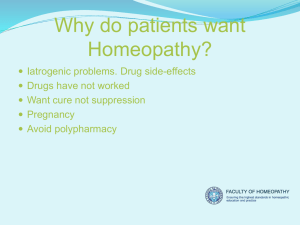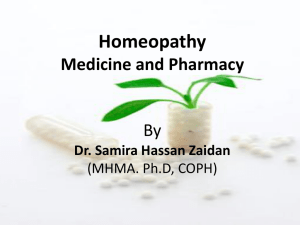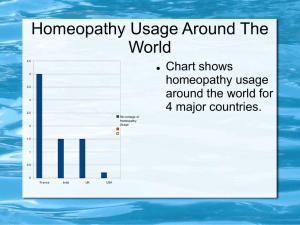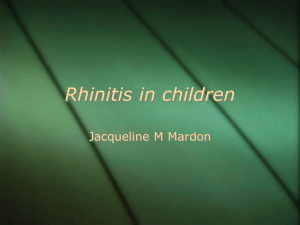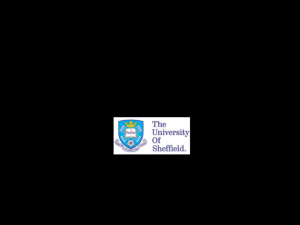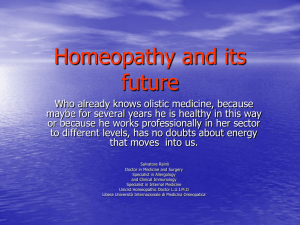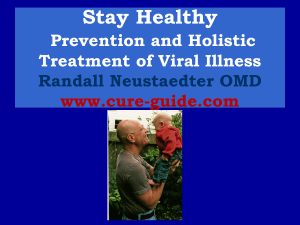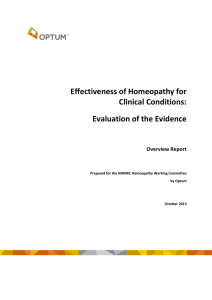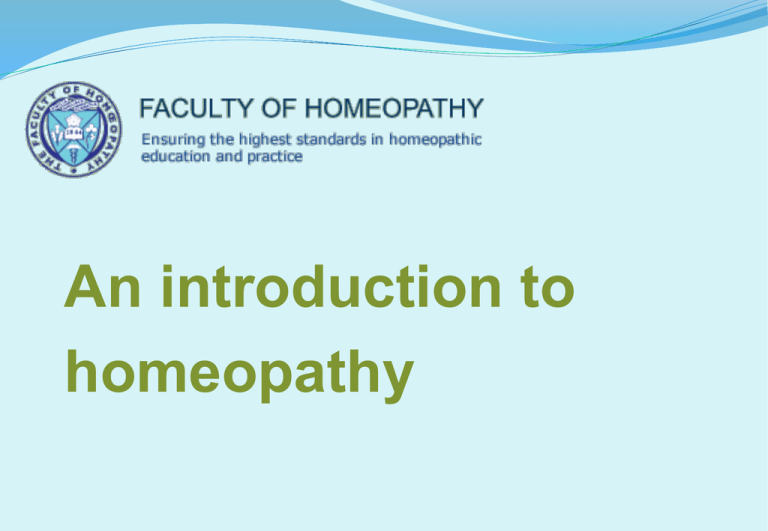
An introduction to
homeopathy
Why learn about homeopathy?
Your patients are using it
Your colleagues are using it
There is a clinical need for it
It’s rewarding
Patient demand
OTC sales of homeopathic remedies: £38 million in 2007 and
predicted to reach £46 million by 2012
Pharmacies and supermarkets selling homeopathic medicines:
Tesco, Sainsbury’s, Boots and many others
British Homeopathic Association website receives around
80,000 visits from the general public a year
Patient demand
ROYAL LONDON HOMEOPATHIC HOSPITAL
- in the year 2004 :
3,300 new out-patients
25,000 follow-up appointments
Patient demand
GLASGOW HOMEOPATHIC HOSPITAL
- in the year 2004 :
1,528 new out-patient consultations
7,400 follow-up appointments
515 new in-patients
Threat to close the in-patient service a few years ago
withdrawn due to intense public lobbying
Patient demand
BRISTOL HOMEOPATHIC HOSPITAL - 2004
1,100 new out-patient consultations
3,500 follow-up appointments
LIVERPOOL HOMEOPATHIC HOSPITAL - 2004
684 new out-patient consultations
6,468 follow-up appointments
Patient demand
15% of the UK population trust homeopathy (TGI Global
barometer, January 2008)
A poll of 3,373 people found that 79% would like to be able to
access complementary medicine alongside conventional
treatment in the NHS (One Poll, January 2009)
Why learn about homeopathy?
Your patients are using it
Your colleagues are using it
There is a clinical need for it
It’s rewarding
Professional demand
Professional demand for training
20-25% of Scottish GPs have had some homeopathic training
There are 54,000 homeopathic medical doctors and other
healthcare professionals in Europe. Between 25% and 40% of
European healthcare practitioners prescribe homeopathy
occasionally, 7% on a regular basis
Lothian GP Survey
305 of 540 Lothian GPs replied
90% of respondents had recommended or referred patients for
a complementary therapy
109 GPs said they wished training in a complementary therapy
most of these stated homeopathy as the therapy of choice
95% said they were willing to refer patients for homeopathic
treatment
64% wanted such a provision in a hospital out-patient setting
B.M.A. “Complementary Medicine,
New Approaches ....”
“One of the main reasons for the current upsurge of ‘official’
interest in non-conventional medicine is the rapidly increasing
number of patients who are seeking help from such
practitioners. This has prompted the Council of Europe to
state : ‘It is not possible to consider this phenomenon as a
medical side-issue. It must reflect a genuine public need which
is in urgent need of definition and analysis.’ ”
Why learn about homeopathy?
Your patients are using it
Your colleagues are using it
There is a clinical need for it
It’s rewarding
The clinical place of homeopathy
Where there is no effective conventional alternative
Where conventional medicine is unsafe
Where conventional medicine has unacceptable side-
effects
To minimize the use of conventional medicine
No effective conventional treatment
Allergies
Anal fissures
Anger
Bruises
Chilblains
Colic
Fear/phobias
Glandular fever
Grief
Impotence
No effective conventional treatment
Intermittent claudication
Mastalgia
M.E. / CFS / PVS
Nightmares / night terrors
Premenstrual Syndrome
Teething
Urethral syndrome
Unsafe situation for
conventional medicine
Pregnant women
Young children
The elderly
Anticipatory anxiety
Unacceptable side-effect profile
Anxiety
Depression
Cramps
Osteoarthritis
Reduction in long-term
conventional treatment
Asthma
Constipation
Convulsions
Dysmenorrhoea
Eczema
Migraine
Neuralgias
Otitis media ( recurrent )
Psoriasis
Why learn about homeopathy?
Your patients are using it
Your colleagues are using it
There is a clinical need for it
It’s rewarding
The rewards of homeopathy
Making a difference
Patient satisfaction
Effects on consultation technique
Intellectual achievement
The joy of detective work
Making sense of patterns of disease
Making sense of progress of disease
Understanding aetiology
What is homeopathy?
Like cures like
Minimum effective dose
How are remedies prepared?
Original sources
Plant
Mineral
Animal
Disease
Serial dilutions
Succussion
Is there a phenomenon here?
Clinical research
Clinical experience
Consistency of theory
Professional attitudes
British Journal of Pharmacology, 2006 – a study by University of
Aberdeen of Scottish general practices found that 49% had
prescribed homeopathy (323 practices in total)
The doctor’s mag Pulse reported on a survey of 200 GPs in 2007 -
56% had either provided or recommended complementary
medicine to patients
RCTs - the meta-analyses
Kleijnen J, Knipschild P, Ter Riet G. Clinical trials of
homeopathy. British Medical Journal 1991; 302: 316-323
Linde K, Clausius N, Ramirez G, et al. Are the clinical effects of
homeopathy placebo effects? A meta-analysis of placebocontrolled trials. Lancet 1997; 350: 834-843
Linde’s conclusion
Linde's conclusion is: "The results of our meta-analysis are not
compatible with the hypothesis that the clinical effects of
homeopathy are completely due to placebo”
A reading of the study shows a clearly positive result for
homeopathy
49% of the trials were clearly positive and a further 35%
showed a positive trend
Kleijnen’s conclusions
They found that of 105 trials with interpretable results, 81
were positive
They then looked at a sub-group of the most rigorous trials and
discovered that 15 out of 22 found homeopathy to be superior
to placebo
One of Kleijnen's conclusions was that the evidence found:
'would probably be sufficient for establishing homeopathy as a
regular treatment for certain conditions'
The Lancet – August 2005
110 homeopathy trials were compared with 110 allopathy
trials
Overall positive treatment effect found in both groups
Final analysis limited to “best” 8 homeopathy and 6 allopathy
trials – significant effect of homeopathy disappeared
Conclusion: “The clinical effects of homeopathy are those of
placebo”
Lancet editorial: “The end of homeopathy”!
Lancet 2005 – the flaws
Standard assessment criteria are insufficient to gauge “high
quality” in homeopathy trials
Authors did not state which 8+6 trials were analysed in details
so their relevance or value was unknown
8 trials of homeopathy cannot fairly represent the entire
research literature!
Authors ignore homeopathy’s significant effects in RTIs
Some key papers are omitted, others wrongly included
The rigour and validity of the paper’s conclusions were
rebutted in later articles (Rutten and others, 2008)
Categories of research evidence
The medical conditions for which the published literature
substantiates the clinical value of homeopathic treatment can
be ranked in 3 categories:
1. Systematic reviews with positive conclusions in specific clinical
areas
2. More than one published clinical trial favouring homeopathy
3. One positive published clinical trial only…
1. Systematic reviews with focus on
specific clinical areas
Allergies and upper respiratory tract infections
Childhood diarrhoea
Influenza
Post-operative ileus
Rheumatic diseases
Seasonal allergic rhinitis
Upper respiratory tract diseases, including otitis media
Vertigo
2. Replicated trials with a majority of
positive findings
Childhood diarrhoea
Fibromyalgia
Influenza
Osteoarthritis
Seasonal allergic rhinitis
Sinusitis
Vertigo
3. Singleton trials with positive
evidence
Includes…
Chronic fatigue syndrome
Premenstrual syndrome
Post-partum bleeding
Sepsis
Stomatitis
Outcome studies:
Bristol Homeopathic Hospital
Observational study of 6,544 consecutive follow-up patients
over 6 year period in an NHS hospital outpatient unit
Outcomes were based on scores on a 7-point Likert-type scale
70.7% reported positive health changes, with 50.7% recording
their improvement as better (+2) or much better (+3)
Outcome studies:
Royal London Homeopathic Hospital
Outcome study of 500 asthma patients
Of 262 who had been taking conventional medicines, 29%
were able to stop conventional treatment and 32% reduced
their conventional treatment.
BMJ, Nov 2007:
“A principle of evidence based practice is that the evidence
should be only one influence on clinical decision making,
alongside the expertise and perspectives of both patients
and clinicians. However uncomfortable for health system
planners, an evidence based service should reflect expressed
patient preference.” David Tovey, Editor of BMJ Knowledge
Taking a homeopathic history
Presenting complaints
Systems review
PMH
FH
SH
Allergies
Generals
Mentals
Analysing the data
Significant symptoms
Materia Medica patterns
Repertorising
Basic homeopathic principles
Single remedy, Single dose
Potency
Direction of cure
Basic homeopathic principles
Single remedy, single dose
Potency
Direction of cure
Potency
Series of Dilutions and Succussions
Two common Scales in UK
x or Decimal scale - serial 1:9 dilutions
c or Centesimal scale - serial 1:99 dilutions
Each Potency written as number, then scale symbol:
2x, 3x, 6x, 12x, etc.
6c, 12c, 30c, 200c, M, 10M, CM, MM
Basic homeopathic principles
Single remedy, single dose
Potency
Direction of cure
Direction of cure
Most important organs to least important
Inwards to outwards
Top to bottom
Reverse order of appearance of symptoms
Prescribing a Remedy
NHS or private
Pharmaceutical supply
Local chemist
Specialist homeopathic pharmacies such as Ainsworths,
Freemans, Helios, Nelsons or Weleda
Stock order
Cost
Obtaining homeopathic treatment
NHS
GP
Homeopathic hospital (Bristol, Glasgow, Liverpool, London)
In-patient (Glasgow only)
Out-patient
Homeopathic clinics around the country
Private practitioners
Medically qualified
Non-medically qualified
First prescriptions
Infant Colic
Colocynthis
Night Cramps
Cuprum metallicum
What is complementary medicine?
Definitions a) “additional to western medicine” or “not taught in medical
schools” ( GP survey )
b) “all forms of health care which usually lie outside the official
health sector” ( WHO )
c) “those forms of treatment which are not widely used by
orthodox health-care professions, and the skills of which are
not taught as part of the undergraduate curriculum of
orthodox medical and paramedical health-care courses” (BMA)
What is complementary medicine?
Acupuncture
Alexander technique
Aromatherapy
Bach Flower Remedies
Chiropractic
Crystal therapy
Healing
Herbalism
Homeopathy
What is complementary medicine?
Hypnotherapy
Iridology
Kinesiology
Massage
Osteopathy
Radionics
Reflexology
Shiatsu
Hospital-based complementary
medicine
Outpatient care
Inpatient care
Teaching
Faculty of Homeopathy
The only body in the UK that promotes the education and
training of healthcare professionals in homeopathy
1400 members worldwide in a range of different professions
including doctors, nurses, dentists, vets, midwives,
pharmacists, podiatrists and osteopaths
Accredited training available in the UK and overseas
www.facultyofhomeopathy.org

